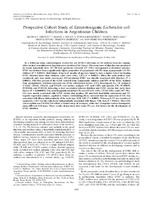Please use this identifier to cite or link to this item:
http://sgc.anlis.gob.ar/handle/123456789/306| Title: | Prospective Cohort Study of Enterotoxigenic Escherichia coli Infections in Argentinean Children | Authors: | Viboud, Gloria I. Jouve, Mabel J. Binsztein, Norma Vergara, Marta Rivas, Marta Quiroga, Marina Svennerholm, Ann-Mari |
Keywords: | Infecciones por Escherichia coli;Estudios de Cohortes;Lactante;Argentina;Escherichia coli | Issue Date: | Sep-1999 | Publisher: | American Society for Microbiology | Journal: | Journal of clinical microbiology | Abstract: | In a follow-up study, enterotoxigenic Escherichia coli (ETEC) infections in 145 children from two communities located in northeastern Argentina were monitored for 2 years. The occurrence of diarrhea was monitored by weekly household visits. Of 730 fecal specimens collected, 137 (19%) corresponded to diarrheal episodes. ETEC was isolated from a significantly higher proportion of symptomatic (18.3%) than asymptomatic (13.3%) children (P 5 0.04541). Individuals of up to 24 months of age were found to have a higher risk of developing ETEC diarrhea than older children (odds ratio [OR], 3.872; P 5 0.00021). When the toxin profiles were considered, only heat stable enterotoxin (ST)-producing ETEC was directly associated with diarrhea (P 5 0.00035). Fifty-five percent of the ETEC isolated from symptomatic children and 19% of the ETEC isolated from asymptomatic children expressed one of the colonization factors (CFs) investigated, i.e., CF antigen I (CFA/I), CFA/II, CFA/III, and CFA/IV; coli surface antigens CS7 and CS17; and putative CFs PCFO159, PCFO166, and PCFO20, indicating a clear association between diarrhea and ETEC strains that carry these factors (P 5 0.0000034). The most frequently identified CFs were CFA/IV (16%), CFA/I (10%), and CS17 (9%). CFs were mostly associated with ETEC strains that produce ST and both heat-labile enterotoxin and ST. Logistic regression analysis, applied to remove confounding effects, revealed that the expression of CFs was associated with illness independently of the toxin type (OR, 4.81; P 5 0.0003). When each CF was considered separately, CS17 was the only factor independently associated with illness (OR, 16.6; P 5 0.0151). Most CFs (the exception was CFA/IV) fell within a limited array of serotypes, while the CF-negative isolates belonged to many different O:H types. These results demonstrate that some CFs are risk factors for the development of ETEC diarrhea. |
Description: | Fil: Viboud, Gloria I. ANLIS Dr.C.G.Malbrán. Instituto Nacional de Enfermedades Infecciosas. Departamento de Bacteriología; Argentina. Fil: Jouve, Mabel J. ANLIS Dr.C.G.Malbrán. Instituto Nacional de Enfermedades Infecciosas. Departamento de Bacteriología; Argentina. Fil: Binsztein, Norma. ANLIS Dr.C.G.Malbrán. Instituto Nacional de Enfermedades Infecciosas. Departamento de Bacteriología; Argentina. Fil: Vergara, Marta. Universidad Nacional de Misiones. Cátedra de Bacteriología; Argentina. Fil: Rivas, Marta. ANLIS Dr.C.G.Malbrán. Instituto Nacional de Enfermedades Infecciosas. Departamento de Bacteriología; Argentina. Fil: Quiroga, Marina. Universidad Nacional de Misiones. Cátedra de Bacteriología; Argentina. Fil: Svennerholm, Ann-Mari. University of Göteborg. Department of Medical Microbiology and Immunology; Suiza. |
URI: | http://sgc.anlis.gob.ar/handle/123456789/306 http://jcm.asm.org/content/37/9/2829.full.pdf+html |
ISSN: | 1098-660X | DOI: | 10.1128/JCM.37.9.2829-2833.1999 | Rights: | info:eu-repo/semantics/openAccess Creative Commons Attribution 4.0 International License |
| Appears in Collections: | snrd Publicaciones INEI |
Files in This Item:
| File | Description | Size | Format | |
|---|---|---|---|---|
| JournalofClinicalMicrobiology,1999,37(9),2829–2833..pdf | Artículo en inglés | 74.95 kB | Adobe PDF |  View/Open |
Page view(s)
241
checked on Jan 15, 2026
Download(s)
82
checked on Jan 15, 2026
Google ScholarTM
Check
Altmetric
Altmetric
This item is licensed under a Creative Commons License


